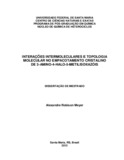| dc.creator | Meyer, Alexandre Robison | |
| dc.date.accessioned | 2017-05-10 | |
| dc.date.available | 2017-05-10 | |
| dc.date.issued | 2013-02-26 | |
| dc.identifier.citation | MEYER, Alexandre Robison. Intermolecular interactions and molecular topology in
crystal packing of 3-amine-4-halo-5-methylisoxazoles. 2013. 141 f. Dissertação (Mestrado em Química) - Universidade Federal de Santa Maria, Santa Maria, 2013. | por |
| dc.identifier.uri | http://repositorio.ufsm.br/handle/1/10542 | |
| dc.description.abstract | In this work is described the intermolecular interactions and the molecular
topology present in the crystal packing of 3-amine-4-halo-5-methylisoxazoles. First
was described the obtention of the 3-amine-4-halo-5-methylisoxazoles by
halogenations of the compound 3-amine-5-methylisoxazol with N-chlorosuccinimide,
N-bromosuccinimide and N-iodoosuccinimide. The crystal packing of the 3-amine-4-
halo-5-methylisoxazoles show a great variety of intermolecular interactions such as:
hydrogen bonding, halogen bonding, π π interactions and C-H π interactions.
Further analysis of crystal packing showed that these compounds have a molecular
coordination number equal to 14. The correlation between molecule molecule
energy contact and the contact area between the molecules showed that, with the
exception of dimmers formed by strong hydrogen bonds, all the other interactions
have a large dependence of the contact area. The melting enthalpy of the 3-amine-4-
halo-5-methylisoxazoles grows with the increases of the total energy of the contacts
of the clusters, showing that these physic property depends of the intermolecular
interactions present in the crystal. The analysis of theory levels used to determine the
molecule molecule energies contact demonstrates that, when is used the method
counterpoise for basis set superposition error (BSSE), the level of theory MP2/Augcc-
pVDZ show energy values very close to the energy at the MP2/cc-pVTZ level of
theory. The functional B97-D and ωB97X-D, based on the DFT theory, also showed
satisfactory energy values, very close to those obtained by MP2. | eng |
| dc.description.sponsorship | Coordenação de Aperfeiçoamento de Pessoal de Nível Superior | |
| dc.format | application/pdf | por |
| dc.language | por | por |
| dc.publisher | Universidade Federal de Santa Maria | por |
| dc.rights | Acesso Aberto | por |
| dc.subject | Isoxazóis | por |
| dc.subject | Interações intermoleculares | por |
| dc.subject | Topologia molecular | por |
| dc.subject | MP2 | por |
| dc.subject | Isoxazoles | eng |
| dc.subject | Intermolecular interactions | eng |
| dc.subject | Molecular topology | eng |
| dc.title | Interações intermoleculares e topologia molecular no
empacotamento cristalino de 3-amino-4-halo-5-metilisoxazóis | por |
| dc.title.alternative | Intermolecular interactions and molecular topology in
crystal packing of 3-amine-4-halo-5-methylisoxazoles | eng |
| dc.type | Dissertação | por |
| dc.description.resumo | Neste trabalho são descritas as interações intermoleculares e a topologia
molecular referente ao empacotamento cristalino de 3-amino-4-halo-5-metilisoxazóis.
Primeiramente foi descrita a obtenção dos 3-amino-4-halo-5-metilisoxazóis através
da halogenação do composto 3-amino-5-metilizoxazol com N-clorosuccinimida, Nbromosuccinimida
e N-iodosuccinimida. O empacotamento cristalino dos 3-amino-4-
halo-5-metilisoxazóis apresentou uma grande diversidade de interações
intermoleculares incluindo: ligações de hidrogênio, ligações de halogênio, interações
π π e C-H π. Uma análise mais detalhada do empacotamento cristalino
demonstrou que estes compostos apresentam um número de coordenação
molecular igual a 14. A correlação entre a energia de contato molécula molécula e
a área de contato entre as moléculas demonstrou que, com exceção dos dímeros
formados por ligações de hidrogênio fortes, as demais interações apresentam uma
grande dependência da área de contato. A entalpia de fusão dos 3-amino-4-halo-5-
metilisoxazol aumenta com o aumento da energia total do cluster demonstrando que
esta propriedade física está vinculada as interações intermoleculares presentes no
cristal. A análise dos níveis de teoria utilizados para determinar as energias de
contato molécula molécula demonstra que ,quando utilizado o método
counterpoise para o erro de sobreposição de bases (BSSE), o nível de teoria
MP2/Aug-cc-pVDZ apresentou valores de energia muito próximos ao do nível
MP2/cc-pVTZ. Os funcionais B97-D E ωB97X-D, baseados na teoria DFT também
apresentaram valores de energia satisfatórios, muito próximos aos obtidos pelo
MP2. | por |
| dc.contributor.advisor1 | Martins, Marcos Antonio Pinto | |
| dc.contributor.advisor1Lattes | http://lattes.cnpq.br/6457412713967642 | por |
| dc.contributor.referee1 | Ducati, Lucas Colucci | |
| dc.contributor.referee1Lattes | http://lattes.cnpq.br/1605430966535142 | por |
| dc.contributor.referee2 | Frizzo, Clarissa Piccinin | |
| dc.contributor.referee2Lattes | http://lattes.cnpq.br/0029279904716491 | por |
| dc.creator.Lattes | http://lattes.cnpq.br/5028033620704356 | por |
| dc.publisher.country | BR | por |
| dc.publisher.department | Química | por |
| dc.publisher.initials | UFSM | por |
| dc.publisher.program | Programa de Pós-Graduação em Química | por |
| dc.subject.cnpq | CNPQ::CIENCIAS EXATAS E DA TERRA::QUIMICA | por |


